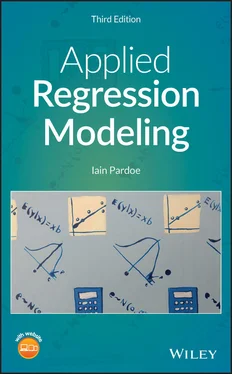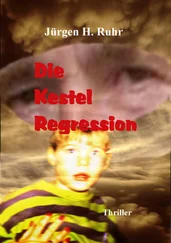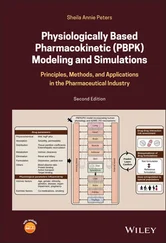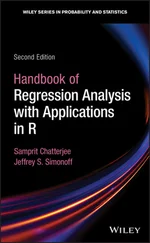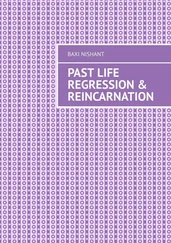305 298
306 299
307 299
308 300
309 301
310 302
311 303
312 304
313 305
314 306
315 307
316 308
317 309
318 310
319 311
320 312
Applied Regression Modeling
Third Edition
Iain PardoeThompson Rivers University The Pennsylvania State University

This edition first published 2021
© 2021 John Wiley & Sons, Inc
Edition History
Second Edition, 2012, John Wiley & Sons, Inc
All rights reserved. No part of this publication may be reproduced, stored in a retrieval system, or transmitted, in any form or by any means, electronic, mechanical, photocopying, recording or otherwise, except as permitted by law. Advice on how to obtain permission to reuse material from this title is available at http://www.wiley.com/go/permissions.
The right of Iain Pardoe to be identified as the author of this work has been asserted in accordance with law.
Registered Office
John Wiley & Sons, Inc., 111 River Street, Hoboken, NJ 07030, USA
Editorial Office
111 River Street, Hoboken, NJ 07030, USA
For details of our global editorial offices, customer services, and more information about Wiley products visit us at www.wiley.com.
Wiley also publishes its books in a variety of electronic formats and by print‐on‐demand. Some content that appears in standard print versions of this book may not be available in other formats.
Limit of Liability/Disclaimer of Warranty
While the publisher and authors have used their best efforts in preparing this work, they make no representations or warranties with respect to the accuracy or completeness of the contents of this work and specifically disclaim all warranties, including without limitation any implied warranties of merchantability or fitness for a particular purpose. No warranty may be created or extended by sales representatives, written sales materials or promotional statements for this work. The fact that an organization, website, or product is referred to in this work as a citation and/or potential source of further information does not mean that the publisher and authors endorse the information or services the organization, website, or product may provide or recommendations it may make. This work is sold with the understanding that the publisher is not engaged in rendering professional services. The advice and strategies contained herein may not be suitable for your situation. You should consult with a specialist where appropriate. Further, readers should be aware that websites listed in this work may have changed or disappeared between when this work was written and when it is read. Neither the publisher nor authors shall be liable for any loss of profit or any other commercial damages, including but not limited to special, incidental, consequential, or other damages.
Library of Congress Cataloging‐in‐Publication Data
Names: Pardoe, Iain, 1970- author
Title: Applied regression modeling / Iain Pardoe, Thompson Rivers
University, The Pennsylvania State University.
Description: Third edition. | Hoboken, New Jersey : Wiley, [2020] |
includes bibliographical references and index.
Identifiers: LCCN 2020028117 (print) | LCCN 2020028118 (ebook) | ISBN
9781119615866 (cloth) | ISBN 9781119615880 (adobe pdf) | ISBN
9781119615903 (epub)
Subjects: LCSH: Regression analysis. | Statistics.
Classification: LCC QA278.2 .P363 2020 (print) | LCC QA278.2 (ebook) |
DDC 519.5/36–dc23
LC record available at https://lccn.loc.gov/2020028117
LC ebook record available at https://lccn.loc.gov/2020028118
Cover Design: Wiley
Cover Image: Courtesy of Bethany Pardoe
To Bethany and Sierra
The first edition of this book was developed from class notes written for an applied regression course taken primarily by undergraduate business majors in their junior year at the University of Oregon. Since the regression methods and techniques covered in the book have broad application in many fields, not just business, the second edition widened its scope to reflect this. This third edition refines and improves the text further. Details of the major changes for the third edition are included at the end of this preface.
The book is suitable for any undergraduate or graduate statistics course in which regression analysis is the main focus. A recommended prerequisite is an introductory probability and statistics course. It is also appropriate for use in an applied regression course for MBAs and for vocational, professional, or other non‐degree courses. Mathematical details have deliberately been kept to a minimum, and the book does not contain any calculus. Instead, emphasis is placed on applying regression analysis to data using statistical software, and understanding and interpreting results. Optional formulas are provided for those wishing to see these details and the book now includes an informal overview of matrices in the context of multiple linear regression.
Chapter 1reviews essential introductory statistics material, while Chapter 2covers simple linear regression. Chapter 3introduces multiple linear regression, while Chapters 4 and 5 provide guidance on building regression models, including transforming variables, using interactions, incorporating qualitative information, and using regression diagnostics. Each of these chapters includes homework problems, mostly based on analyzing real datasets provided with the book. Chapter 6 ( www.wiley.com/go/pardoe/AppliedRegressionModeling3e) contains three in‐depth case studies, while Chapter 7 ( www.wiley.com/go/pardoe/AppliedRegressionModeling3e) introduces extensions to linear regression and outlines some related topics. The appendices contain a list of statistical software packages that can be used to carry out all the analyses covered in the book (each with detailed instructions available from the book website www.wiley.com/go/pardoe/AppliedRegressionModeling3e), a table of critical values for the t‐distribution, notation and formulas used throughout the book, a glossary of important terms, a short mathematics refresher, a tutorial on multiple linear regression using matrices, and brief answers to selected homework problems.
The first five chapters of the book have been used successfully in quarter‐length courses at a number of institutions. An alternative approach for a quarter‐length course would be to skip some of the material in Chapters 4 and 5 and substitute one or more of the case studies in Chapter 6 ( www.wiley.com/go/pardoe/AppliedRegressionModeling3e), or briefly introduce some of the topics in Chapter 7 ( www.wiley.com/go/pardoe/AppliedRegressionModeling3e). A semester‐length course could comfortably cover all the material in the book.
The website for the book, which can be found at www.wiley.com/go/pardoe/Applied RegressionModeling3e, contains supplementary material designed to help both the instructor teaching from this book and the student learning from it. There you'll find all the datasets used for examples and homework problems in formats suitable for most statistical software packages, as well as detailed instructions for using the major packages, including SPSS, Minitab, SAS, JMP, Data Desk, EViews, Stata, Statistica, R, and Python. There is also some information on using the Microsoft Excel spreadsheet package for some of the analyses covered in the book (dedicated statistical software is necessary to carry out all of the analyses). The website also includes information on obtaining a instructor's manual containing complete answers to all the homework problems, as well as instructional videos, practice quizzes, and further ideas for organizing class time around the material in the book.
Читать дальше
